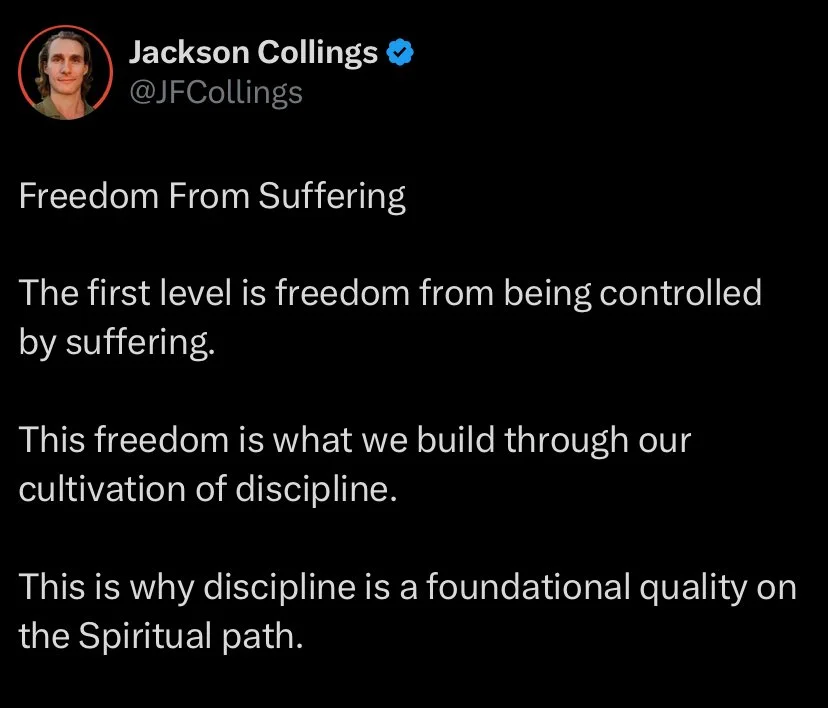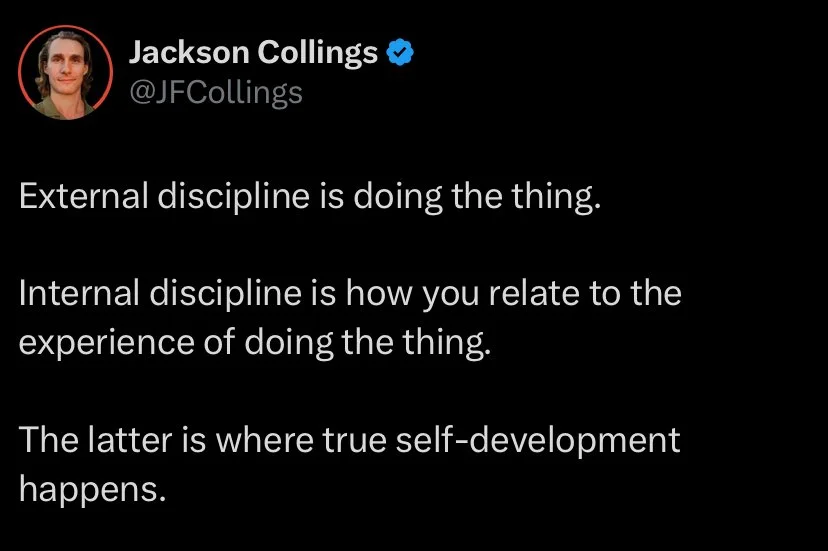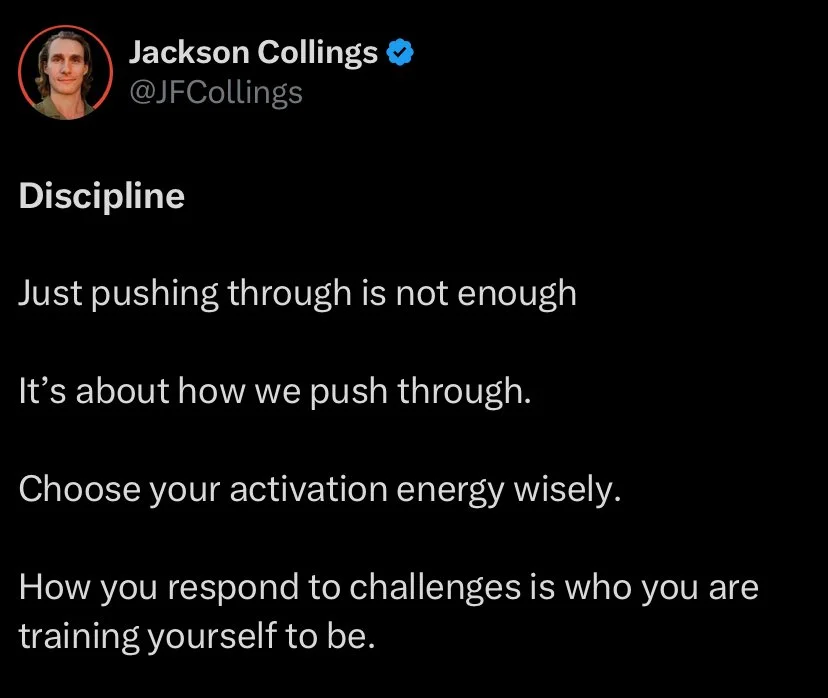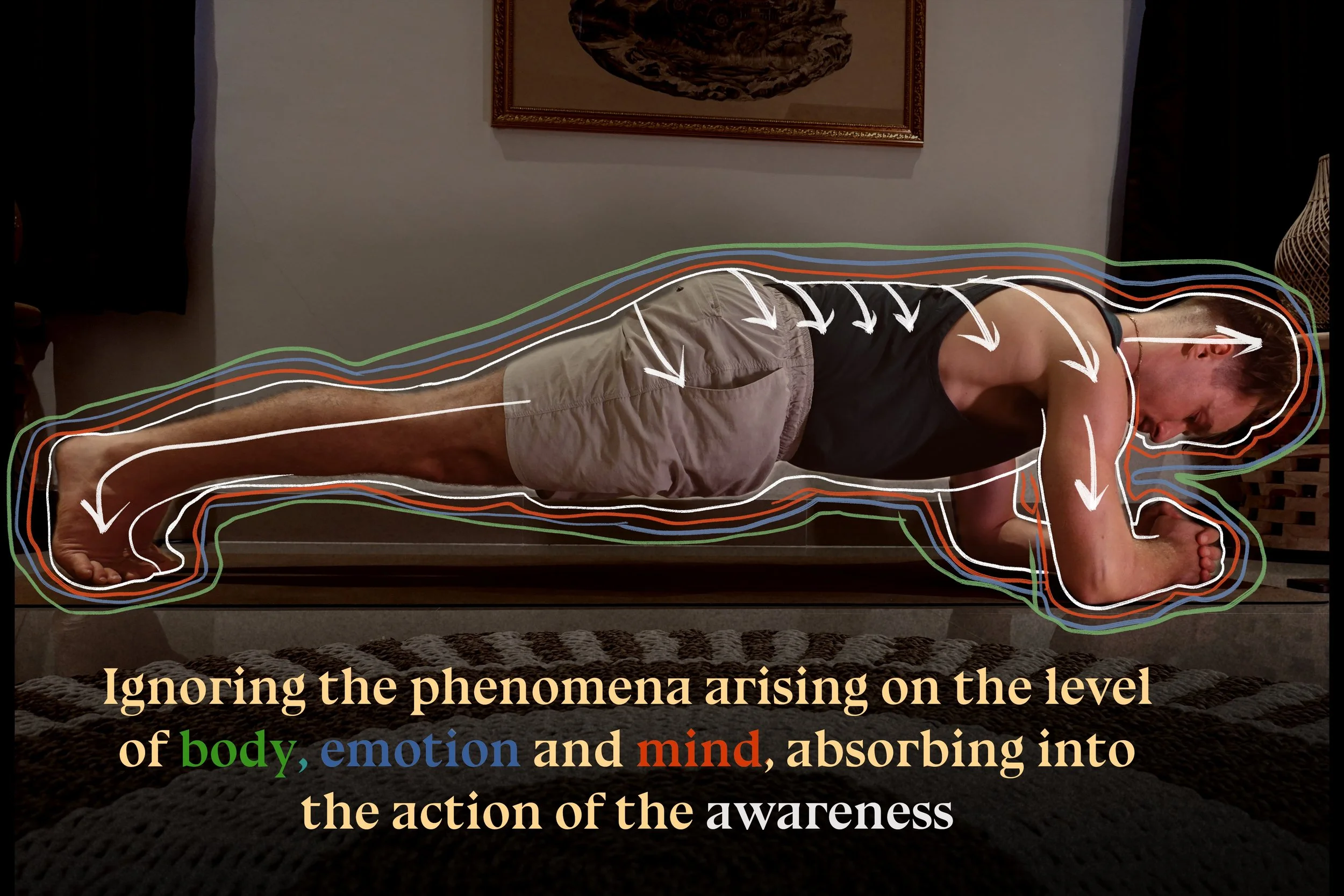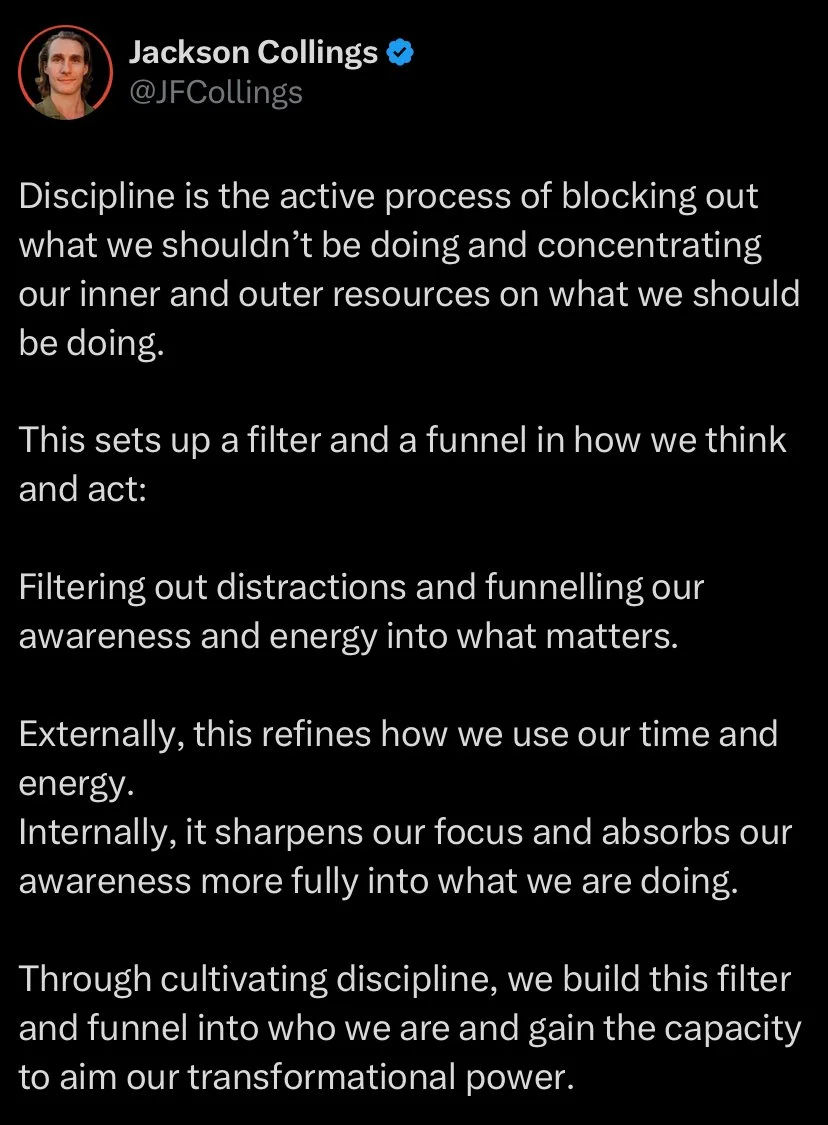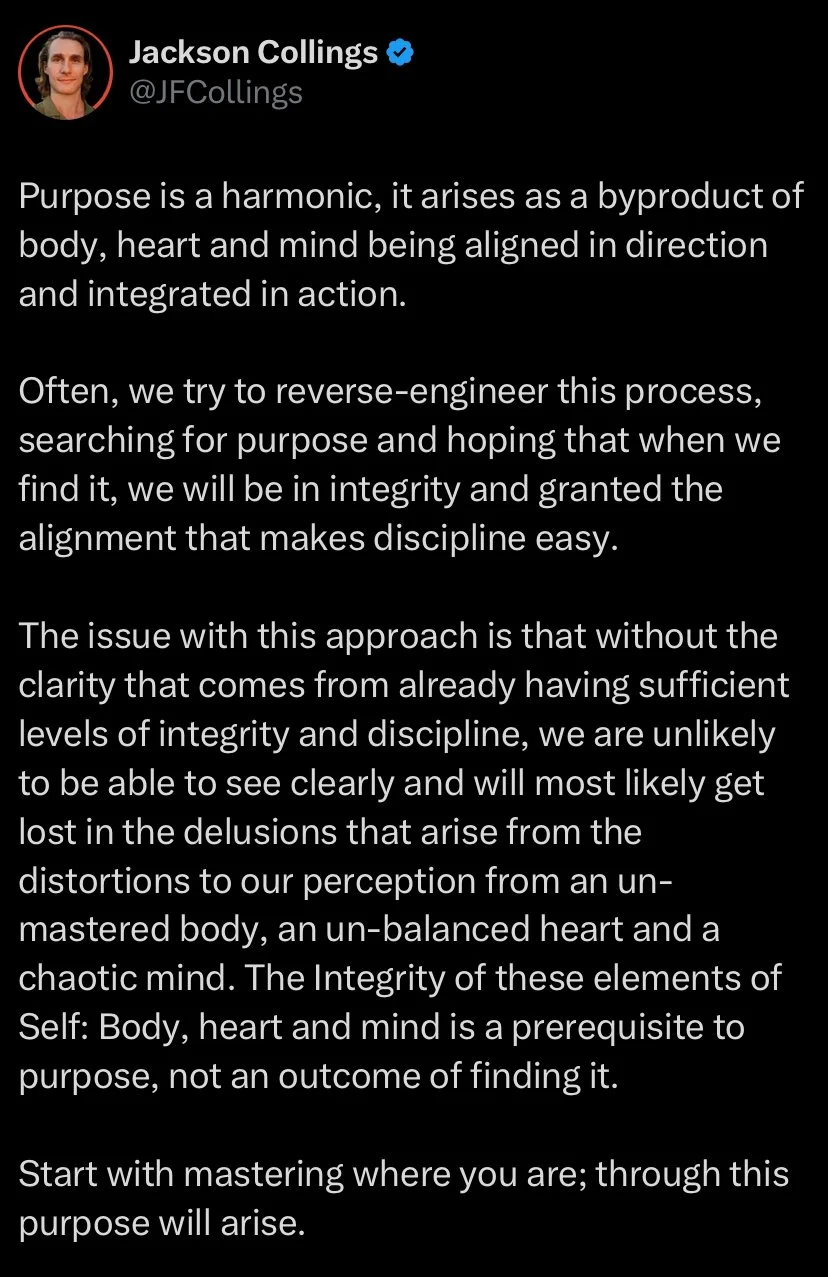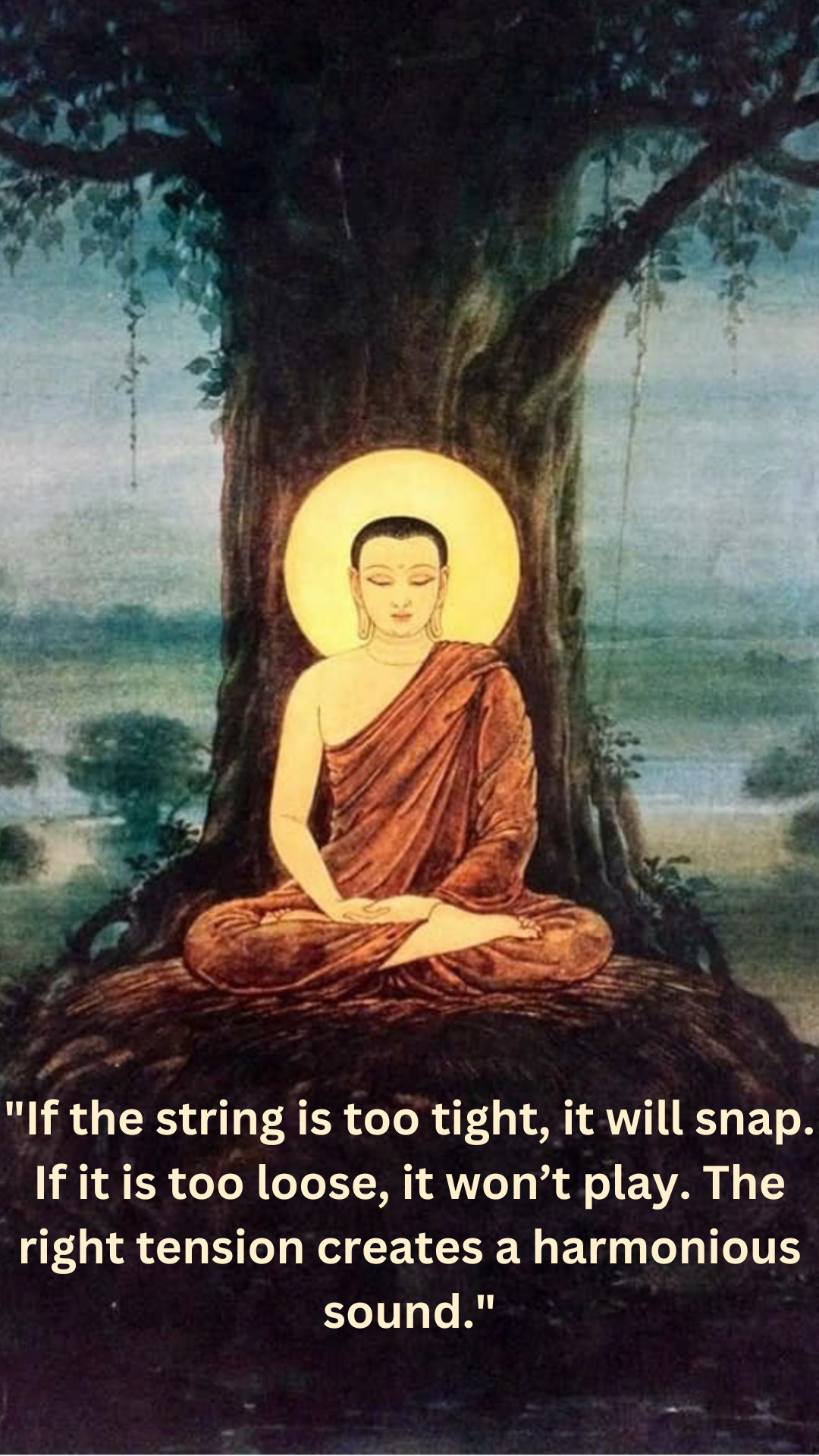Discipline
In any endeavour, whether it is improving our state of being or achieving something in the world, we must sustain effort over time and overcome the barriers to and challenges of change. Inherent to this process will be friction and resistance.
The forms that this friction and resistance take are countless. From the energy cost of completing a task, the strain on the body of transforming, to the barriers in the world we need to work through to achieve our aims.
Whether the barriers to change exist within us, in our circumstances, or in the world, we will experience the resistance, friction, and potential discomfort they cause through our bodies, emotions, and minds.
Discipline is the key to transcending this resistance and using it as fuel to create growth and transformation.
In this article I will explore why I think this is true and how to do it.
I will cover:
The two expressions of discipline
The application of discipline in physical training
The mental triggers for discipline
Discipline as the study and practice of how we relate to discomfort
The self-transformation that can happen through discipline
The developmental causation chain of discipline
The subjective experience of the discipline causation chain
How to ‘do’ discipline and what to apply it to
I am writing this article as much for myself as for anyone else. My aim is to refine my understanding of Discipline and its transformational mechanics so I can be more effective in my cultivation. I also wish to share this understanding because I believe it will be helpful for some in clarifying how to approach the development of discipline and how it fits into the greater journey of self-development and spiritual cultivation.
Please remember, the ideas presented here are just that—ideas. They aren’t an attempt at absolute truth or the final word on discipline. Their purpose is to aim awareness into deeper dimensions of being, intended to help us better understand our nature and the mechanisms that shape our experience. I offer this caveat because I tend to write in a certain tone; don't mistake that certainty for the belief that this is the final truth. Instead, see it as a drive in the exploration. Now, let's dive in.
Martial Arts for Spiritual Cultivation
In early 2023, I joined Damo Mitchell's full-time five-year Internal arts training project in Southeast Asia. A project aimed at bringing a group of long-term students deep into the arts and creating practitioners with a high level of expertise.
Through this long-term training process, alongside energetic and meditative training, martial arts are a key aspect of our development and one of the foundational tools we are using to develop the correct qualities in mind and body.
Early on in one of the very first lectures, Damo outlined how we would be using martial arts for the path of spiritual cultivation. He introduced to us two key expressions of discipline we were to develop, and he gave us a developmental causation chain of how the cultivation of the quality of discipline serves as a path of self-mastery and spiritual cultivation.
We were taken into the journey of martial arts training from the perspective of using it as a tool to transform how our bodies and minds respond to stress. One of the aims of this training is to develop the capacity to stay calm and centered under pressure and through challenges.
Maintaining a stable nervous system under pressure is crucial for sustaining meditative qualities beyond the meditation cushion and amidst the turbulence of life.
For those who walk the path of spiritual cultivation but have not chosen to renounce the world and live in seclusion, mastering the body's relationship to stress is a key foundation for sustained progress. This is one of the purposes of martial arts training on the spiritual path.
On this path, the quality of discipline goes beyond a basic level of self-control and into the realm of it being a path of freedom. Freedom of the self from slavery to the mundane and a way to begin anchoring identity in aspects of being beyond the body, emotions and mind. This is a way to build the foundations for freedom from suffering.
For 18 months, I have been working on these two expressions of discipline and using this Causation chain as a developmental framework. In this article, I would like to share what I have learnt so far through this process.
Before writing this article, I asked Damo if it was ok for me to write on these ideas he had shared with us, and he was happy for me to do so. However, please bear in mind that what I am drawing on here is my personal experience in applying these ideas and finding a way to make sense of them for myself. Any incongruence or lack of sense in these concepts belongs to my interpretation.
The Two Disciplines
Discipline 1: The Discipline of Overcoming How You Feel
The skill of NOT being controlled by what arises in the body, emotions and mind.
The capacity to sustain a course of action regardless of the body, emotions and mind.
Discipline 2: The Discipline of Overcoming Boredom
The skill of keeping your awareness fully engaged in what you are doing
The skill of not being controlled by the movements of the mind
Discipline applied in physical training
For the sake of simplicity, let us use the example of performing a plank as a physical exercise we can use to cultivate discipline. This exercise is a great way to get an immediate sense of how we relate physically, emotionally and mentally to challenge. While this exercise lacks the longer time exposure that is useful for cultivating deeper levels of discipline, for now it will suit our purpose well for a general overview of the mechanics of discipline and the subjective experience of discipline’s application.
So I enter my plank, and my cultivation of discipline can begin.
Somatic sensations start to arise. Tension, the feeling of stretching and working muscle fibers, perhaps heat and tremors in the tissues. For many, who are experiencing a new level of discomfort outside of their normal bandwidth of experience, this physical discomfort can also cause levels of emotional discomfort.
With the arising of physical discomfort and for some, potentially emotional discomfort also, we have entered the domain in which we can begin applying Discipline 1: Overcoming How We Feel.
On a basic level, the application of Discipline 1 can be as simple as the choice to continue with the exercise regardless of the discomfort. I think of this as an aspect of discipline in which the mind is developing mastery over the body.
This first step of discipline (this first application of discipline 1), this decision to continue with the work regardless of the discomfort, begins the process of transformation that can arise through the cultivation of this quality. A decision has been made, a mental action has been chosen to be master over physical sensation and perhaps over emotion too. With this, the layers of body, emotion and mind have begun to be separate.
Even this first step serves as a metaphor for what the skill and quality of discipline can bring to our lives. It is a micro-training ground for how we relate to life's stress, and it is a place where we can develop our capacity for a greater level of agency. Here, we are developing the skill and strength to hold to an ideal, an aim, or a plan regardless of the discomfort and challenge it presents.
Triggers for Discipline
At the level of mind-over-body discipline, we are using an idea or thought to tap into discipline.
Not all thoughts/ideas are made equal as triggers for discipline, and we need to be aware that by using a thought, its ‘shape’ and its inherent associated emotional pattern will be trained into our system as the pattern that will activate in response to stress.
There are skillful and unskillful thoughts and ideas for triggering discipline
On the skilful end, we have thoughts and ideas that promote the development of qualities connected to self-mastery and self-agency. These thoughts connect us to our drive to be better and trigger motivation to strive for growth. They connect us to our values and who we know we can be. There is no end to the development of the sorts of qualities these thoughts foster, as we can always have greater and greater levels of agency and self-mastery.
Skillful thought:
“ I am a person who finishes what they start”
On the unskillful end, we have thoughts that put our motivation and our power outside ourselves and make our efforts dependent upon external factors like the environment we are in or the people we are with. The issue with these kinds of thoughts as triggers for discipline is that as soon as the external factor they are dependent upon is gone, they have no utility. For example, if the trigger is “I want person A to see how skilled I am”, as soon as person A is gone, this idea has no power. This kind of approach entrains a detrimental attitude whereby we will forever be at the mercy of the external world.
Unskillful thought
“ I will show X person how strong I am”
Perhaps this level of analysis of the mental process of discipline is pedantic. However, it is essential that we recognise that discipline is about more than just ‘pushing through’; it is about how we push through. We must recognise that the thoughts, attitudes, emotions, and aspects of self we use to push through are what will be cultivated with our discipline. Further down the line, the mental and emotional forms we use to trigger discipline will become the unconscious patterns that activate in response to stress.
So we have been holding the plank for a little while now.
It Is here at this level of challenge that we encounter how interwoven the layers of self are. Does the discomfort trigger emotions? And if it does, do we feel these emotions at core of who we are or just as more noise in the nervous system?
Does the discomfort trigger the mental processes of trying to escape what we are experiencing?
Do we let any of these processes take over control of our body, causing us to fidget, adjust our position or twitch our head to check the time?
Or do we stay locked in, mind sharp, absorbed in what we are doing, letting all the phenomena of the body, emotions and mind arise and fall away without us reacting or getting sucked into them.
Relationship to Discomfort
One of the mechanisms of self we begin to work on through the cultivation of Discipline 1: Overcoming how we feel is the mechanism of habitual identification with the sensations of the body.
How intense or unpleasant discomfort is, depends upon how much we let our awareness get sucked into the sensation and identify with it. The spectrum of – ‘’There is the somatic sensation of heat, tension and pressure feeling in the abbs” to “My abbs are on fire” to “I am hurting”.
The degree to which we identify with the sensation, letting it pull us in and become our point of reference, determines the degree to which we will suffer. This is one of the mechanisms that transforms through the cultivation of discipline.
Instead of letting our awareness get pulled into the sensations of discomfort, cultivating discipline leads to us absorbing more into what we are actually doing. We do not block out the discomfort, we just let it be and instead double down on focusing on the task at hand.
From this, more internal space starts to open up, our awareness can begin to disembed from the structures in the physical, emotional and mental layers of our being it was previously held within. This enables us to have greater clarity of these as distinct separate layers of phenomena whilst also giving us a greater level of discernment in recognizing what we really are (awareness) and what is just a phenomenon in the body and mind.
Discipline 2 Overcoming Boredom
Discipline 2 (overcoming boredom) for me tends to become more relevant once I have locked into Discipline 1 and overcome the feelings or if the feelings are not intense enough to need much Discipline 1.
Discipline 2 seems highly relevant in the moments between things or when the intensity is not high enough to demand full attention, when it is easier for the mind to wander.
Yesterday in martial arts class, we received an instruction related to Discipline 2. We were practicing striking in the traditional manner, where we performed the striking combination on the count that the teacher called out. This meant standing in a state of readiness, ready to immediately move with efficiency through the combination precisely when we hear the count called
‘’One!’’ – Jab, cross, front kick, Jab, step back.
‘’Two!’’ – Jab, cross, front kick, Jab, step back.
“Three!’’ – Jab, cross, front kick, Jab, step back.
Between counts, we were told not to move, not to fidget, not to look around, but to wait poised and ready for the next count.
This trained discipline 2: Overcoming boredom. Training the capacity to stay in control of the various aspects of self, unifying one’s being in action, not letting body, emotion, or mind lead away from the task at hand. Instead, training awareness and the unified self to be the governor. Training this unified self to stay on task both during the moments of max energy expenditure and in the moments of waiting.
So far we have looked at an initial expression of Discipline 1- using thought to trigger discipline, how the process of identification determines the level of discomfort and we have looked at Discipline 2 and how we can use it to stay centered and focused . This is a good starting point, but on the path of cultivation, we must go deeper!
We must keep going until discipline is an implicit quality that comes from us applying our awareness to what we are doing. I believe the way to develop this is that once we have decided what we are doing, as quickly as possible, we shift our awareness to being solely focused on and absorbed IN what we are doing.
This means not constantly triggering thoughts or ideas to keep going, this means being fully engaged in what we are actively doing.
Back to the plank. In this exercise, What I am ‘actively’ doing is widening my lower back, lengthening by spine and seeking to use the elasticity of spreading my tissues from my center all the way out to the parts that are in contact with the ground; at the same time, I am actively stopping unnecessary muscles from recruiting. These actions are what I absorb my attention
As I work at this over time, the awareness stops getting pulled so strongly into sensations and instead moves to a state where it stabilises on the focal point of what I am actively doing.
When the awareness has a stable focal point and is not constantly being sucked into distractions, it starts to coalesce and thicken, so to speak. For me this leads to a sense of more of the substance of awareness and the process of identification starts to anchor into awareness itself rather than the phenomenon of body, emotion and mind.
Identification and self-transcendence
Cultivating discipline leads to the practice and study of how our reference point, the aspect of our being we identify with and is, therefore, our lens for reality, determines the nature and quality of our experience. This study and practice leads to the development of the skill of residing in deeper aspects of our being as our reference point; this skill, in many ways, is what sits at the core of the spiritual path.
On a practical level, this point of reference, this lens, is the subjective experience of self. Going forward, I will also refer to this point of reference/Lens/point of identification as the self.
This lens, this ‘self,’ is a mix of memories, emotional patterns, biases and preferences, habitual attitudes, mental constructs, somatic patterns, and conscious and unconscious value structures. The summation of all these elements into one unified structure that distorts reality into our experience is what we experience subjectively as self.
For most, the ‘self’ is a tangled mix of physical, emotional and mental forms and patterns fused together by our experiences into the jumbled mass we experience as our ‘self’. This structure acts as the lens and filter for reality.
Operating with this structure as our point of reference, we reinforce its form and shape, and through the mechanisms of aversion, attraction, and emotional reactivity, this structure, this ‘self’ becomes stronger, tightening its grip on our awareness.
The cultivation of discipline is a path to begin untangling this knotted structure, freeing ourselves from its parasitical consumption of our energy and awareness and developing a greater level of agency over the process of identification.
The path of discipline is a path of transcending the base level of self and cultivating who and what we are into something higher. It is a way we can evolve the self from an instinctive reactive thing into something imbued with high ideals and oriented to purpose.
A blessing of the path of discipline is its accessibility. We can walk this path through physical training and how we relate to discomfort. Any physical, emotional or mental discomfort we experience is essentially from the self or the process of identification. By exposing ourselves to discomfort and challenge and practicing the two types of discipline, we can reshape the self and develop more freedom over the mechanism of identification.
The key aspect of discipline I am seeking to bring clarity to is that it is not about just pushing through, but how we do it and that we use it as a vehicle for introspection and self-awareness. This approach is about using discipline to initiate a transformative opening out of the layers of our self (body, emotion, mind, awareness) and using discipline to sustain and stabilise this opening under pressure. It is all well and good to be able to enter states of being anchored into awareness in relaxing peaceful moments (on our meditation cushion perhaps), but through cultivating discipline, mainly through challenge to the body, we can develop robustness and stability to be able to sustain positive qualities under duress.
This is one of the purposes of martial arts for spiritual cultivation. To take the stress threshold of ones body and nervous system to a much higher level so that the positive qualities developed in meditative practice can sit on the foundation of a nervous system that can stay stable and calm in the face of adversity. Meditative training alone does not do this, and the qualities developed in meditation rely on the foundation of the nervous system being stable.
Cultivating Discipline
The cultivation of Discipline is twofold:
First, we have the active direct work of using physical training and our relationship to discomfort, what we have just explored.
Second, we have the cultivation of discipline in life. This is the development and application of discipline in our lifestyle and work. Using the power of discipline to align the self and our actions to the way of living and being that is necessary to achieve our aims. Using discipline to live by our values and align with the highest ideals of who we can be.
The first aspect of discipline is internally focused, it is managing how we relate to discomfort, emotion, and thought in a fixed process. The second application of discipline has additional external aspects as it is applied to our actions in the world via the management of time, energy, and attention. It's no longer just about our internal processes; it's also about the choices we make and the reasons behind them.
This second aspect of applying discipline to life beyond training is where I have found the development of the Discipline Causation chain to be most visible for myself. I think this aspect of discipline is also required for the discipline we build in training to bleed through into our lives and become an inherent quality in who we are.
The Discipline Causation Chain
In this discipline cultivation process, I have been working mostly on the Discipline > Purpose stage. When I have done this well, I have begun tapping into the Purpose > Direction stage. And I have had times of glimpsing the Direction > function stage.
Working at the Discipline > Purpose stage, I have noticed two other qualities begin to arise, both as a side effect of building discipline and also as the key additional factors necessary for purpose to start arising in this causation chain.
These two qualities are Integrity and Efficiency.
By integrity, I am referring to a structural and functional alignment of the aspects of self. The greater the degree of this integrity, the more all aspects of self can function as one whole, with all parts moving in one direction, not fighting each other or creating tension by going in different directions; harmonised and aligned in action.
By Efficiency, I am referring to the effective use of time and energy. This applies both in the efficiency of how something is done and in how efficiently one manages the space between the things being done.
Locking into integrity seems to be about doing the right things and not doing the wrong things. The right things are those that are expressions of our values and morals and lead us closer to our aims. The wrong things are actions disconnected from our values, not morally aligned and that detract from our positive momentum. As behaving in this manner becomes the default, the various aspects of our being come into greater alignment and efficiency begins to arise as a byproduct
Working directly at becoming more efficient in how we do things, both internally in how our energy and awareness are engaged with what we do and externally in the efficiency of our actions and behaviours, will also develop integrity.
Integrity and efficiency are interconnected mutually reinforcing qualities, very much two sides of the same coin.
I believe both these qualities arise as a byproduct of Discipline; however, I think it is also beneficial to directly work on them in our cultivation. Integrity and Efficiency can be actively cultivated by:
Integrity - Defining one’s values, morals and aims, and then increasing behaviours that align with these and minimising or eliminating behaviours that do not.
Efficiency – Externally by not wasting one's time and energy and instead investing it in aligned actions and behaviours. Internally, by the management of awareness and energy in how we are doing things, being focused on what we are doing, eliminating distractions, etc.
One useful aspect of cultivating efficiency as part of this process is that it is easily measured. It is usually quite simple to determine how efficient we are in what we are doing and how we can become more efficient. Reflecting on actions in this way can provide us with clear feedback on how to improve.
In the past I sought to find purpose, it has now become abundantly clear that the real sense of purpose, the one that enriches, inspires, motivates and drives us, is not something that we can think our way into. Purpose is not something we can get to by brainstorming or visioning, these things can be useful for getting a direction we want to move in, for determining what It could look like if we lived out our values, and they may trigger inspiration and motivation, but they will not create purpose. They can show us the path we should apply discipline too, then perhaps purpose will start to arise.
Purpose is a quality that is born as a byproduct of discipline (and integrity + efficiency). This Purpose is a harmonic that arises when the prerequisite qualities are in place. This purpose is not one thing, it is not a particular plan or idea of the future, it is a quality of being that suffuses everything we do, we become purposeful.
Personally, I find this notion empowering, and I feel it simplifies things and makes purpose more accessible. All we need to do is apply discipline to align the aspects of ourselves into action, and if we do this, purpose will come to us.
I have found that when I lock into discipline and manage to stabilise integrity and efficiency, the energy I expend in work doesn’t go away; instead, it seems to turn into momentum. With this comes a shift of focus from me and my needs to the needs of this momentum. I get ‘caught up in it’ so to speak; my own bullshit doesn’t matter so much anymore, and I am in service to the perpetuation of this momentum, I would call this purpose.
From this place of service to the momentum, service to purpose, I have found that my relationship to life and the world shifts. I start to have an embodied sense of a trajectory, a great path ahead, pulling me forward. This feels like a connection to something greater than who and what I am now. From this sense of trajectory, this sense of purpose, the steps of how to get from here to there come into sharp clarity, and I feel magnetised forwards on this long path spanning forward far into the future; I am calling this Direction. When I am tapped into this Direction, I experience greater levels of energy and function start to arise.
A few months ago, I hit the balance right; I was locked into discipline, the harmonic of purpose was stable, the direction was showing itself clearly and heightened function started to arise. I locked into this, and for 3 weeks, I experienced something akin to a constant flow state; my normal cognitive function went to a much higher level; in particular, the capacity for metacognition (thinking about thinking) stabilised at a level I had previously only glimpsed for short periods. I was able to hold multiple complex ideas in my mind and in the background of my thinking, filter these ideas through decision frameworks whilst also generating structured step-by-step plans for executing these ideas, and all this would happen in seconds whilst having a conversation about the idea. It was excellent and very useful. I saw this as an experience of the function aspect of the discipline causation chain starting to arise. Through the cultivation of discipline and what arises from this, my system was starting to adapt to function more effectively for what I was engaged in. Interestingly, the heightened function that arose was not necessarily in the training I was explicitly building discipline in, but in the work I was doing at the time and the functions of mind that made the doing of this work much more effective.
This is my subjective of seeking to cultivate the discipline causation chain to my life. Whilst I would love to always function at the higher ends of this causation chain, I find it is a fickle thing—and so am I! Sometimes, it is on, I feel magnetised to a greater purpose, and there is more energy and momentum flowing through me than I can keep up with. And often, it is a slow grind of pushing through the resistance of my body, emotions, and mind.
It is all relative; initially, greater levels of purpose and capacity can be a highly enriching experience, but if we keep going, what was enriching will be normalised.
The key here is to judge the value of what we are doing NOT by how we feel but instead by how aligned we are with what matters and how much effort we are deploying in its pursuit.
Pitfalls
Discipline, as a mental quality, causes a focusing, a centering, and an activation of a type of mental strength. This quality, when regularly cultivated and used, will have numerous effects on the body, emotions and mind. Overall, these effects are vastly positive. However, the potential downside lies in the tension the pursuit of discipline can create and the danger of this leading to rigidity and stagnation.
I know I have been too one-sided in my cultivation, not balancing discipline with qualities that promote openness and release when:
I stop noticing the beauty of the world
I am laughing less
I become impatient with others
A frown or focused gaze becomes my default expression.
Things start becoming a bit grey
I am not enjoying life.
Cultivating discipline should not come at the expense of openness.
There are many important qualities that sit on the other side of the spectrum from discipline, qualities that create opening and release in our minds and bodies. Alongside cultivating discipline, it is essential that we also cultivate the qualities of the openness and release end of the spectrum. One of these qualities that is most accessible is gratitude.
I will write in-depth on Gratitude in the future; for now, I will simply say that if you are cultivating discipline, it is essential that you are also cultivating a quality like gratitude.
Not in a passive manner, not in a half-ass, think about it now and then manner; it must be done explicitly and actively, ideally as regularly as you are actively cultivating discipline.
There are many ways to cultivate gratitude, and many of you reading this will already have your methods, so I will outline some key aspects of cultivating gratitude.
Develop the skill of triggering the somatic feeling of gratitude. This can be done via positive memories or ideas of things that would create gratitude in us. Once the somatic feeling has arisen seek to sustain it without it needing a thought or memory.
Actively regularly practice seeing things in your life and activating gratitude for them. Apply this to people, places, things, experiences, circumstances, everything and anything.
Develop the capacity to have gratitude as a background quality in your body and mind as you go about your day. Once the capacity to hold the somatic feeling/pattern of gratitude has been developed, lightly activate and sustain this quality in the background of your awareness as you go about your day-to-day activities.
Cultivating gratitude or similar qualities alongside discipline is essential in guarding against the rigidity and stagnation that can arise from only working at discipline. Doing this will help the mind and self open more, enabling the transformative power of the discipline to travel into deeper layers of being. This correct balancing of mental qualities is core to success in cultivation and is a fundamental component of the spiritual path.
What to cultivate Discipline through
Physical training in which you push your limits
Your work and projects, practicing staying focused on what you are doing
Tunning your lifestyle to be one that fosters your growth and wellbeing. Adopting behaviors that promote growth and wellbeing and eliminating behaviors that negatively impact you.
To Integrity: Define your values, determine what behaviors express/embody/align with/ these values. Determine what you are doing that is not in alignment with your values. Apply discipline to adopting and sustaining the behaviours that align and eliminate those that detract.
For anyone wanting to bring clarity to what integrity is to you and how to cultivate it and apply discipline to it. Please see the short journaling exercise below.
Thank you
Thank you for taking the time to read this article, I hope that it brings benefit to your path of cultivation.
Let’s wrap this up with summarsing definition of this take on discipline.
This approach to cultivating Discipline involves using physical training and the way we live to instil the character trait of discipline into our being.
Through physical training we create challenge and discomfort that we then use as a tool to study the relationship between the layers of our being and how we identify with them.
This becomes the study of the mechanism of identification and how the self formulates itself via the phenomenon that arises on the physical, mental, and emotional layers of our being. This is a path of freeing our awareness from its habitual identification with the patterns in these layers. This builds the beginnings of freedom from suffering and is the essential prerequisite for deeper spiritual work.
This is the inner journey that discipline takes us on.
The outer journey is using the power of choice and commitment that discipline gives us to live with a greater level of alignment to our values and greater efficiency in our actions. This can cause the harmonic of purpose to arise and lead us into higher levels of capacity and direction in life.
One of the challenges we face in cultivating discipline is that it can lead to rigidity and stagnation. To counter this we must also cultivate qualities like gratitude that promote an opening and expansion of the self.
Without discipline and the freedom from being controlled by suffering it creates, we are forever stuck at a level of self that is entrenched in identifying with the positive and negative experiences of body and mind.
With discipline, we have the strength to continue the work and keep the fire of transformation alive within us so that we may stabilise who we are beyond the levels of body and mind.

